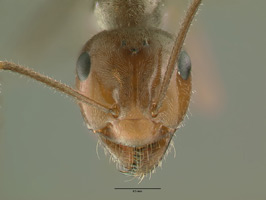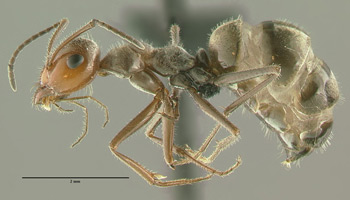- Identification
- The genus Myrmecocystus can be differentiated from other Nearctic Formicinae by their elongate maxillary palpi. The fourth segment is as long as, or longer than, the combined lengths of the two following segments. Myrmecocystus romainei is a medium-sized species best recognized by the abundant erect hairs of the malar area and the uniformly short hairs on the occiput, promesonotum and gaster. The color of the head and thorax of the workers varies from light to medium ferruginous to more brown and rather dark coloration.
- Biology
- Myrmecocystus romainei occurs in a variety of habitats. It may nest in fine, deep sand or in compact clayey soil. Large, crateriform tumuli (up to 20 cm in diameter) may be found at the entrance to their ground nests. Foragers are predators and scavengers, and likely visit flowers for nectar. Repletes have not been collected but this species has not been studied in much detail. .
- additional biology notes...
- Distribution
- Range
- United States. Western Kansas, Oklahoma and Texas, westward to Utah and central Arizona.
- Navajo Reservation Records
- Collection records being processed.

Drawing of worker from Snelling (1976)
- Additional Notes
- This species has been found in Bluestem-Grama Prairie, Pinon Juniper Woodland, Trans-Pecos Shrub Savanna, Creosote bush-Tarbush Grassland and, for at least one collection, on the side of a road.
- Repletes
- Myrmecocystus are better known to naturalists by their common name - honeypot ants. While there are numerous varieties of honeypot ants throughout the world this particular genus is restricted to dry habitats in southwestern North America. Individual species can be found from Washington, south to central Mexico and east to Texas. The genus is most diverse in southern California, which hosts eighteen of the twenty-seven named species. The common name of the ants from this genus highlights an unusual feature of their biology. One of the worker castes serves as a living food storage repository. These large workers, or repletes, have gasters that are able to expand to a remarkable degree.
- Repletes are a fascinating adaptation to arid and semi-arid habitat life. Myrmecocystus live in areas where rain is sparse and typically arrives seasonally. The moisture triggers plant growth and reproduction, which in turn creates food resources for many other organisms. Carbohydrate rich exudates of sap sucking insects (aphids and others), galls and extrafloral nectories can readily be gathered in great quantities by foraging ants. Over the course of the year nothing else compares to this seasonally abundant profusion of liquid nutrients. Repletes are an effective way of solving the problem of dealing with the boom and bust nature of these valuable liquid food resources.
- Nests of Myrmecocystus go deep underground and the repletes are typically located in the lower reaches of the nest. Snelling (1976) felt they were placed where there is permanent soil moisture. This positioning of the repletes in the soil column allows for the ants to be kept cool and maintained in a humid environment. The deeper confines of the nest are also presumed to be safer from predators that could potentially prey upon the nutrient rich ants. Other ants, badgers, coyotes and even humans have exploited honeypot ants as a food resource.
- Foraging ants collect honeydew and nectar, return to the nest and regurgitate their food to the repletes. These living storage units suspend themselves from the ceiling of a nest chamber. Individuals are often found in clusters while overall they may be found in numerous chambers in a colony. Engorged individuals can become confined to the chamber where they become filled with liquid. The repletes of some species become the size of small grapes. The transfer of food is reversed during leaner times of the year. Workers will tap their antenna upon the head, mandibles and antenna of a replete to solicit food, which is then readily provided to the repletes' nestmates.
- Etymology
- Patronym. After Marjorie Romaine, the collector of the type specimens.

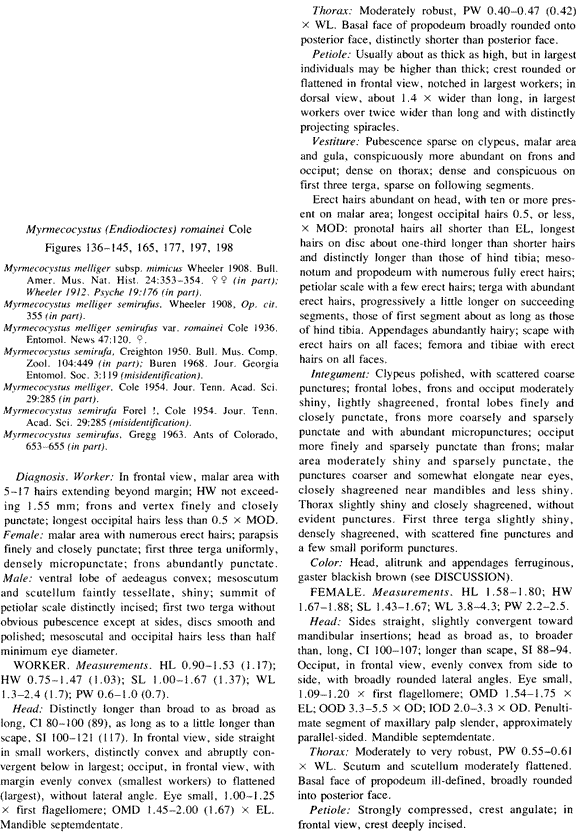
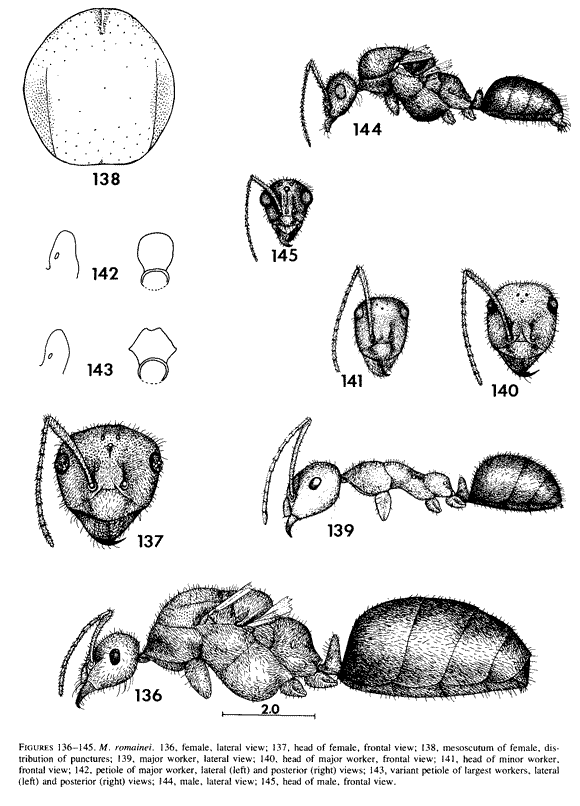
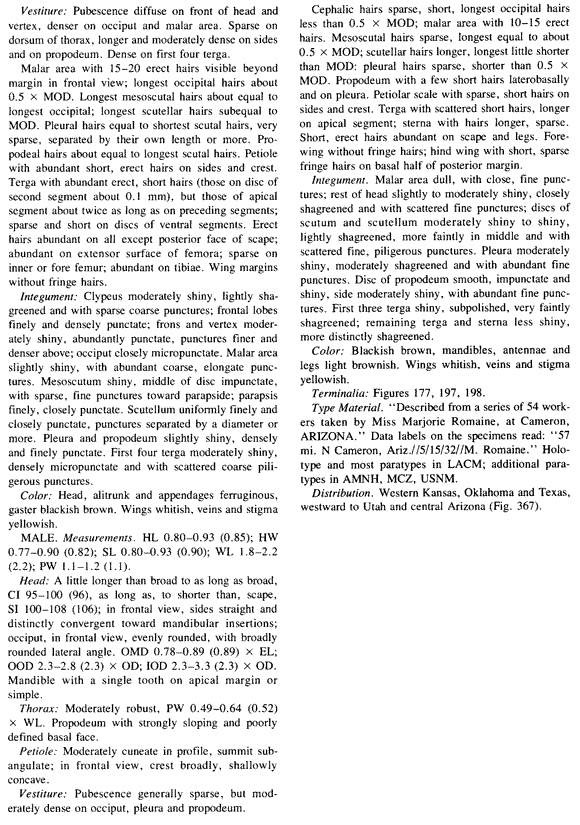
- Literature
- Cole, A. C., Jr. 1936. Descriptions of seven new western ants. (Hymenop.: Formicidae). Entomological News. 47:118-121.
- Hunt, J. H. and R. R. Snelling. 1975. A checklist of the ants of Arizona. Journal of the Arizona Academy of Science. 10:20-23.
- Snelling, R. R. 1976. A revision of the honey ants, genus Myrmecocystus (Hymenoptera: Formicidae). Natural History Museum Los Angeles County Science Bulletin. 24:1-163.
- A note about these publications. The literature cited here is not meant to be an exhaustive list of papers published about this species.
Page authored by David Lubertazzi and Gary Alpert
